-

人教版高中英语必修4A taste of English Humor说课稿3篇
Then I would ask them to think of a funny English or Chinese and tell it to partners. While telling stories, they can use expressions and some acting to help make the story funny. 5 minutes would be given to do this.Those stories they told there will be the material for their writing. Soletting them tell it at first is helpful. And they can make a difference between telling a funny story and writing it down. Generally speaking, it is difficult forstudents to write well because they don’t know what to write and how to write. Asking them to tell their own stories at first can help them come up with what to write.After their telling, I would invite someone to share his/her story with all of us and I would write it down on the blackboard.This example story would be used as a sample to illustrate the format of funny story. Different from a story from teacher or textbook, a story from students can obviously become a interesting material to draw students’ attention.Then I would ask the whole class to put this story into several parts. It might be a little bit difficult for them. So I would ask them to find out whether all the sentences are necessary. After delete some sentences, there are 6 sentences left behind. Then they can easily put them into three parts. After interaction with students, I would teach them the right terms for each part and conclude the format of funny story.This step is the key and difficult point in my lesson. So I mainly usetask-based teaching method in this part and the task for students was divided into several stages. With the separated difficult level, students can find there are usually three parts in writing. They can also learn to write without the unnecessary parts in the process of analyzing. And then I wouldn’t rush to tell them the right terms to them directly. Instead, I would ask them to name them by their own. A confused mind is better for acquiring knowledge.While-writing:Then I would give students 7 minutes to write down this story, without other requirements.With all the preparations in pre-writing, students’ difficulties were cleared. So it would be much easier for them to write down the story within 7 minutes. There are no other requirements because students’ first writing is actually a drafting. It would be revise and edit several times later. Writing, as a skill

人教版高中英语必修4Women of achievement说课稿4篇
Good morning, distinguished judges:It’s my honor to talk about my teaching ideas with you. Today my topic is Women of Achievement. My presentation consists of six parts: the analysis of teaching material and student, teaching aims, key and difficult points, teaching and studying method, teaching procedures and blackboard design.First, let’s focus on the analysis of teaching material. This lesson is from New Senior English for China Student’s Book 4 Unit 1, the reading part. The main topic of the passage is the introduction of a student of Africanwildlife. After this lesson, the students will learn more information about her studying chimps in Africa, and their reading and speaking abilities can be developed as well.The next part is the analysis of students. My students are in senior high students. They have learnt English for many years, they’ve known many words and sentences, but their speaking and reading abilities are still not very good. So I will practice their speaking and reading abilities through different exercises.According to the New Standard Curriculum and the present situation, I set the teaching aims as follows: firstly, knowledge aims. Students can grasp some new words, such as worthwhile, move off. Moreover, students can understand the content of the passage and get familiar with the topic of studying chimps in wildlife. Secondly, ability aims. Students can use reading strategies such as skimming and scanning in reading process. Thirdly, emotional aims. Students can have the awareness of protecting animals and care about animals.Based on the above analysis, the key point of this lesson is to get the main idea and the detailed information from the passage; the difficult point is to talk about the wildlife protection and use reading strategies.

人教版高中英语必修3Festivals around the World说课稿3篇
Teaching plan for Unit 1 book3Good morning, teachers. It’s my great pleasure to be here because I can share my lesson with you and I can learn a lot from it. I’ll begin my lesson from the following four parts, the teaching material, the teaching methods, the studying methods and the teaching procedure.Firstly, let me talk about the teaching material. The content of my lesson is the reading passage festivals and celebrations of Unit 1 Festivals around the world. This passage is about festivals and celebrations. By studying this passage, we’ll enable the students to know that festivals exit everywhere, and many of festivals in different countries celebrate similar ideas. As we all know, the reading passage is the center of each unit. If the Ss can learn it well, it will be helpful to make the Ss learn the rest of this unit.After studying the teaching material, I think the teaching aims are as the followings:1. Knowledge aims:(1) The Ss can master the usage of the important words andexpressions.(2)The Ss can use the __________________ (grammar) in the proper situation.Make students know about the festivals all over the world and the detail of the festivals, such as origin, content, and the date of the holiday festivals.2. Ability aims:(1) Students can talk about festivals and celebrations in English(2) To improve the student’s reading ability, especially their skimming and scanning ability.3. Emotion aims:Make the Ss know about the foreign festivals, and respect other countries’ custom.Next, let’s come to the important points and the difficult points.The important point is how to make the Ss understand the text better and the difficult point is how can they talk about it. secondly, Teaching Methods:1. task-based Language Teaching2. Computer assisted language teaching.3. question-and–answer methodThirdly, Studying Methods:

人教版高中英语必修3The million pound bank note说课稿3篇
在接下来的细读环节,我套用了高考对阅读理解的考查方式设置了5个问题,分别为三个推理判断题,一个细节题和一个主旨大意题。学生需要对文章的内容进行分析、归纳、推理、猜测等高级思维活动才能做出正确的回答。【设计意图】这一过程是对学生进行细读的训练,培养学生获取特定信息和挖掘文章深层次信息的能力。第三环节:Intensive-reading (精读) 15′第三个环节精读,既是最重要的环节,也是突破本课重难点的关键。首先,让学生思考剧本中人物看到百万英镑前后的态度发生了怎样的变化。其次,让学生仔细阅读文章,找出可以表现人物态度变化的具体的语言和动作。最后,让学生总结人物的态度发生变化的根本原因是什么,从而引出Money Talks, 供学生思考。【设计意图】通过一系列的活动培养学生学习从人物的语言和动作探究人物的心理,使学生进一步体会戏剧语言的魅力,从而对文章背后所反映的社会问题进行思考,也为下一步的讨论环节做好铺垫。

人教版高中英语必修5Great scientists说课稿4篇
通过写文章梗概,培养学生综合运用语言的能力,学习用恰当的英语描述科学家的故事。这是本课的教学难点。教师可以使用完形填空的方式来帮助学生整理语篇,从而来降低难度。本课的教学重点的突破方法是:在阅读前,让学生初步了解得出科学观点所需要的基本程序,从而轻松而自然地导入文章的阅读;在阅读过程中,由易到难设计快速阅读和精读的问题,层层推进各种阅读活动,让学生对阅读内容从整体感知到细节理解,最后深层读懂整篇文章,同时加强阅读策略的指导,让每个学生都主动参与课堂教学活动,最终达到提高阅读能力的目的。Step 4 Post-readingGroup Activities四人小组共同合作,在老师的适当指导下,就以下2个问题展开讨论,让学生就所知、所学、所感和所想融入话题,然后抽若干同学代表作小组发言。1. What do you think about John Snow, and what should we learn from him?2. Cholera was 19th century disease, which two diseases are similar to cholera today? Why?

人教版高中英语必修5Life in the Future说课稿5篇
Good afternoon, everyone. It’s my great pleasure to be here sharing my lesson with you. The content of my lesson is Senior English for China Book5 Unit 3 Life in the Future. I’ll be ready to begin this lesson from six parts: Analysis of the teaching material, Analysis of the students, Teaching aims and important and difficult points, Teaching methods and aids, Teaching procedures, and Blackboard design. First, let me talk about the teaching material.Part 1 Analysis of the Teaching Material:This unit is about what human beings’ life will be like in about one thousand years. By studying of this unit, we’ll Enable the students to know the changes in humans’ life and some new inventions bringing about the change and develop the interest in science. This lesson plays an important part in the English teaching in this unit. This is an important lesson in Book Five. From this lesson, it starts asking the Ss to grasp contents of each passage. Therefore, this lesson is in the important position of the teaching material. If the Ss can learn it well, it will be helpful to make the Ss learn the rest of this unit.Part 2 Analysis of the SsAs Senior2 Ss, they are at different levels of English fluency, some of them have lost interest in English. So during the lesson, I arrange a variety of activities to let all of them join in to attract their interest and let them be confident and taste the joy of success.

人教版高中语文必修1《纪念刘和珍君》说课稿3篇
1.说教材《记念刘和珍君》是鲁迅先生用饱醮着热泪,用悲愤的笔调写下的一篇感人至深的散文,既有对爱国青年沉痛的悼念,又有对反动派愤怒的控诉,也有对觉醒的国民的呐喊。《记念刘和珍君》是高中语文必修1第三单元第一课的讲读课文。文中描摹人物的音容笑貌,叙述人物的行为事迹,都融入了作者真挚的情感和深刻的感悟。对学生明辨是非,领悟时代精神和人生意义,有着重要的作用。新课标强调了要全面提升高中学生的语文素养,初步形成正确的世界观、人生观、价值观,并学会收集、判断、处理信息,具有人文素养、创新精神与实践能力。同时,《记念刘和珍君》感情真挚,感悟深刻,具有典型人文性。结合本单元教学目标,确立教学目标如下。

人教版高中语文必修1《鸿门宴》说课稿3篇
3、拓展延伸,启迪心智,创设课堂训练营。三、说学法1、纸上得来终觉浅,圈点、勾画、批注法,学好文言基本功。2、自主合作加探究,眼耳口脑手并用,破疑解难在其中。四、说课时安排《鸿门宴》篇幅较长,文言知识较丰富,文章内涵丰厚,因此我设计用五课时教学本文。第一课时:了解作家作品,积累文言知识,感受作者隐忍发愤的著书精神(初读)第二课时:理清故事情节,概括人物形象,学习客观地评论历史人物,(熟读)第三课时:进一步梳理文言知识,精读课文,要求读透。(精读)第四课时:通过对人物、事件的赏析,加深学生对人物的理解,锻炼学生的开放性思维,由学生自主认识到人物的性格,悲剧的原因等问题。(赏读)第五课时:补充课本教学内容:同学生一起阅读古今关于刘邦项羽的一些篇章:让学生投入进来,把握自己眼中的项羽。(展读)在文言文学习的过程中,采取五步学习法:初读-熟读-精读-赏读-展读(板书)

人教版高中英语必修1Journey Down the Mekong说课稿
2. let the Ss complete the forms paragraph by paragraph. Purpose here is to help Ss to get the habit of reading a passage as a whole, and pay attention to the organization of the text, as a result the Ss will fully understand the whole passage.3. ask Ss to retell the passage with the help of the key words in the form.Since the Ss in the class are in different levels, so I let them to fill in the blank to understand the meaning of the words and phrases better. ( That’s all for the while-reading. Now let’s move to the fifth step.)Step V: Post-reading (10mins) ---DiscussionIn this part students are asked to discuss in groups and list Wang Kun’s and Wang Wei’s attitudes about the trip. After that, Ss are encouraged to express their attitudes with the whole class. Collect their answers and don’t forget to praise them even if their answers may not be perfect.In this activity, discussion provides a vivid and active learning environment for Ss to communicate in English with newly learned language items. (Finally it comes to the homework.)StepⅥ: Homework (1min)1. Ss are required to read the text again after class and figure out the meaning of some complex sentences.2. Do the exercises on P19; This can help Ss to consolidate what they’ve learnt and make preparation for the next lessonPart4. Blackboard design.(说板书设计)On the top, there is the title of this lesson. On the left, there are main ideas for each paragraph. On the right, there are some new words and expressions.Unit 3 Travel journalJourney down the MekongMain idea of each para.:Para1: deciding to take a great bike trip along the Mekong river.Para2: Different attitudes between Wang kun and Wang wei.

人教版高中英语必修3Canada-the true north说课稿4篇
Good afternoon, teachers, It’s my great pleasure to be here sharing my lesson with you.The content of my lesson is Senior English Book 3 Unit 5 Canada —— “The true North”.I’ll be ready to begin this lesson from five parts. Analysis of the teaching material,the teaching methods,the studying methods, the teaching procedure,and Blackboard design.First, let me talk about the teaching material.Part 1 Teaching Material:This unit is about the introduction of Canada. By studying of this unit,we’ll enable the students to learn the geography, population, main cities, and natural beauty, natural resources of Canada. Through the training of the unit, it also requires students to learn some Language skills such as the expressions of position and emotions.So it plays an important part in the English teaching in this book.After studying the teaching material and analyzing the rule of children’s growing of mind,I think the teaching aims are the followings:1.Knowledge objects:(1) make the students learn some new words and phrases(2) make the students understand the content of the lesson.2.Ability objects:(1)To develop the Ss’ abilities of listening, speaking, reading and writing. Especially reading and speaking ability.(2) learn to talk about the characters of Canada in English(3)To train the Ss’ ability of working in pairs.3.Emotion objects:(1)Enable students to understand the characters of Canada..(2)Stimulate Ss to work hard to make China stronger.Part 2 Teaching Methods:I think helping students learn to master new words and phrases and improve the students’ reading and speaking ability is import and the difficult.According to the analysis of the teaching material and the import points and the difficult points,I will use the following teaching methods : question-guiding approach; fast-reading and careful reading; multi-media teaching methods; discussion

人教版高中英语必修5First aid说课稿6篇
In this class, I have 3 teaching aims, that is, knowledge aims, ability aims and emotion aims.1) Knowledge-Teach students new words and expressions, such as temporary, bleed,sprain choke, first aid, fall ill and so on.-Enable students to have a better understanding for some basic knowledge of first aid.2) Ability-Train students’ speaking, reading and writing abilities by different teaching activities, such as skimming, comprehending, team work, role play, retelling and writing.-Develop students’ reading strategy on how to move general idea to specific information.3) Emotion-Promote students’ awareness of giving first aid.- Cultivate students’ creativities.Then let’s come to my teaching methods and activities.III. Teaching methods and activities:To achieve different teaching aims, various kinds of teaching methods and activities will be adopted throughout this period, such as TBL (task-based learning), skimming, team work, brainstorm and others, which can offer students opportunities to fulfill tasks in which they can use language to achieve a specific outcome.IV. Teaching aids:Computer and blackboardV. Teaching important points:1) Make students have a clear mind for the structure of the text.2) Help students understand the theme of the text.VI. Teaching difficulties:1) So many new words may affect students’ understanding.2) How to get students to know about the functions of the skin and thecauses, characteristics and treatments for different degree burns,and the knowledge about giving first aid. VII. Blackboard design:
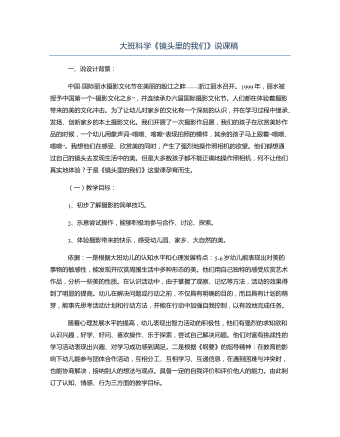
大班科学《镜头里的我们》说课稿
1、初步了解摄影的简单技巧。2、乐意尝试操作,能够积极地参与合作、讨论、探索。3、体验摄影带来的快乐,感受幼儿园、家乡、大自然的美。依据:一是根据大班幼儿的认知水平和心理发展特点:5-6岁幼儿能表现出对美的事物的敏感性,能发现并欣赏周围生活中多种形态的美。他们用自己独特的感受欣赏艺术作品,分析一些美的性质。在认识活动中,由于掌握了观察、记忆等方法,活动的效果得到了明显的提高。幼儿在解决问题或行动之前,不仅具有明确的目的,而且具有计划的萌芽,能事先思考活动计划和行动方法,并能在行动中加强自我控制,以有效地完成任务。
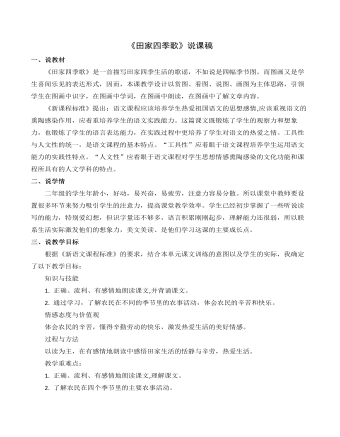
《田家四季歌》说课稿
体会感悟田家生活的恬静与辛劳,热爱生活。很好的完成了这项教学任务,充分发挥学习中的自主性,体现了学生的主体地位,也培养了学生的合作学习能力。

大班科学《认识四季》说课稿
二、说设计意图在孩子们的世界里,燕子、柳条、落叶、雪花。。。都是他们身边常见的景色,但是对于幼儿来讲他们是不能准确的将这些景色与四季明确对应。《纲要》指出,在幼儿生后经验基础上,帮助幼儿了解自然、环境与人类生活的关系,让幼儿从身边入手,培养初步的认识和行为。为此,我设计本次活动具有一定的生活价值。旨在通过活动让幼儿认知四季。幼儿的科学活动是从观察生活的点滴开始的,因为他们的思维都具有直观形象性,作为老师就要引导幼儿在生活中、游戏中去挖掘大自然,并指导孩子进行针对性的观察、比较、认知、创造,这就是最好的教育素材。由此,也就生成了本次科学活动的设计理念。三、说活动目标活动目标是教育活动的起点和归宿,根据中班幼儿的年龄阶段特点和基本动作的发展情况,将本次活动的目标定位于:(1)认知:从自然景色的变化,了解四季的特征(2)技能:培养幼儿根据四季穿衣的能力(3)培养幼儿热爱大自然的情怀第一条目标是主导目标。目的是让幼儿在游戏中认知四季,第二条目标是辅助目标,包括能力目标和感情目标。我想通过孩子们在游戏中的操作代替说教,让孩子获取知识,获取愉快的体验。
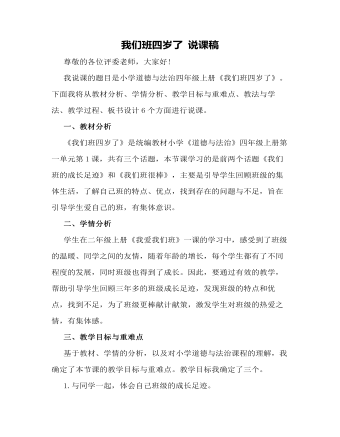
我们班四岁了 说课稿
尊敬的各位评委老师,大家好!我说课的题目是小学道德与法治四年级上册《我们班四岁了》。下面我将从教材分析、学情分析、教学目标与重难点、教法与学法、教学过程、板书设计6个方面进行说课。一、教材分析《我们班四岁了》是统编教材小学《道德与法治》四年级上册第一单元第1课,共有三个话题,本节课学习的是前两个话题《我们班的成长足迹》和《我们班很棒》,主要是引导学生回顾班级的集体生活,了解自己班的特点、优点,找到存在的问题与不足,旨在引导学生爱自己的班,有集体意识。二、学情分析学生在二年级上册《我爱我们班》一课的学习中,感受到了班级的温暖、同学之间的友情,随着年龄的增长,每个学生都有了不同程度的发展,同时班级也得到了成长。因此,要通过有效的教学,帮助引导学生回顾三年多的班级成长足迹,发现班级的特点和优点,找到不足,为了班级更棒献计献策,激发学生对班级的热爱之情,有集体感。三、教学目标与重难点基于教材、学情的分析,以及对小学道德与法治课程的理解,我确定了本节课的教学目标与重难点。教学目标我确定了三个。1.与同学一起,体会自己班级的成长足迹。2.积极地去发现自己班棒在哪里。3.找到班级的问题与不足,乐意为班级成长献计献策。教学重点是:引导学生体会自己班级的成长足迹,为了让自己班级更棒献计献策。难点是:为了让自己班级更棒,乐意为班级出主意、想办法。
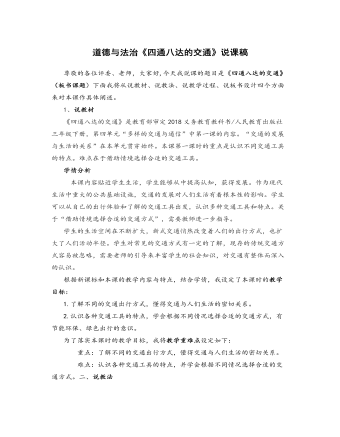
四通八达的交通 说课稿
尊敬的各位评委、老师,大家好,今天我说课的题目是《四通八达的交通》(板书课题)下面我将从说教材、说教法、说教学过程、说板书设计四个方面来对本课作具体阐述。1、说教材《四通八达的交通》是教育部审定2018义务教育教科书/人民教育出版社三年级下册,第四单元“多样的交通与通信”中第一课的内容。“交通的发展与生活的关系”在本单元贯穿始终。本课第一课时的重点是认识不同交通工具的特点。难点在于借助情境选择合适的交通工具。学情分析 本课内容贴近学生生活,学生能够从中提高认知,获得发展。作为现代生活中重大的公共基础设施,交通的发展对人们生活有着根本性的影响。学生可以从自己的出行体验和了解的交通工具出发,认识多种交通工具和特点。关于“借助情境选择合适的交通方式”,需要教师进一步指导。学生的生活空间在不断扩大,新式交通悄然改变着人们的出行方式,也扩大了人们活动半径。学生对常见的交通方式有一定的了解,现存的传统交通方式容易被忽略,需要老师的引导来丰富学生的社会知识,对交通有整体而深入的认识。根据新课标和本课的教学内容与特点,结合学情,我设定了本课时的教学目标:1.了解不同的交通出行方式,懂得交通与人们生活的密切关系。2.认识各种交通工具的特点,学会根据不同情况选择合适的交通方式,有节能环保、绿色出行的意识。
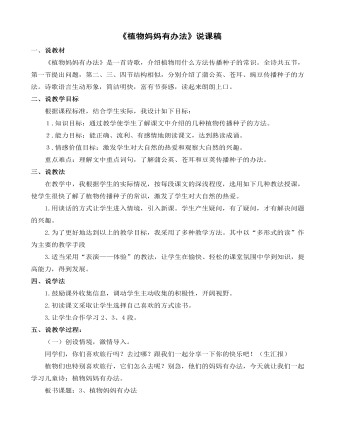
《植物妈妈有办法》说课稿
“纷纷出发”,他们会去哪呢?我来采访一下小蒲公英,你想去哪儿?(公园,田野,树林……)那用我们第一小节的一个词就叫“四海为家”。(四海为家即是走到哪儿,种子就在哪儿生根发芽)
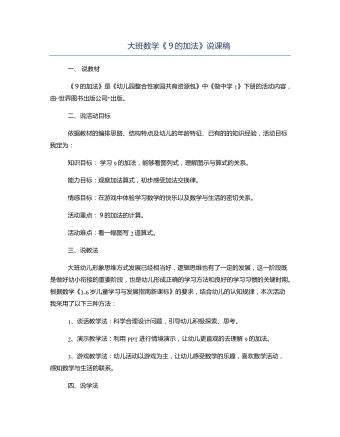
大班数学《9的加法》说课稿
大班幼儿形象思维方式发展已经相当好,逻辑思维也有了一定的发展,这一阶段既是做好幼小衔接的重要阶段,也是幼儿形成正确的学习方法和良好的学习习惯的关键时期。根据数学《3-6岁儿童学习与发展指南新课标》的要求,结合幼儿的认知规律,本次活动我采用了以下三种方法:1、谈话教学法:科学合理设计问题,引导幼儿积极探索、思考。2、演示教学法:利用PPT进行情境演示,让幼儿更直观的去理解9的加法。3、游戏教学法:幼儿活动以游戏为主,让幼儿感受数学的乐趣,喜欢数学活动,感知数学与生活的联系。
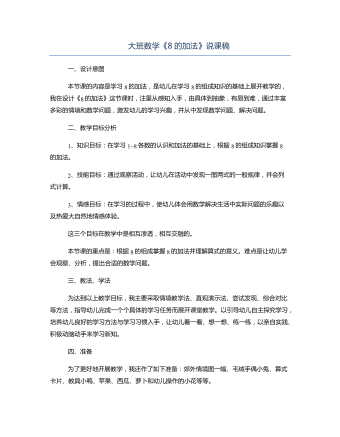
大班数学《8的加法》说课稿
本节课共分为五大环节来进行教学的1、猜拳幼儿,激趣导入针对大班孩子纯真幼稚、富于幻想的心理特征,因此上课一开始进行复习时,我设计了如下导语:小朋友们,智慧爷爷给你们带礼物啦,表现好的都能得到,让我们先来做一个猜拳游戏吧!点出复习题,在这种刺激下,人人都想当老师眼中的小能手,兴趣一下就调动起来。2、创设情境,探究新知在新课学习中,通过孩子们所喜欢的卡通动物形象-----小兔姐姐,以小兔姐姐邀请小朋友去郊游这一情境贯穿全课,从而激发幼儿学习新知的欲望。通过郊外苹果树上的苹果,引导幼儿感知,探索1+7=87+1=8,并发现数量关系,理解算式的意义,然后出示小鸭图,让幼儿提出数学问题,并列出算式2+6=86+2=83、观察算式,发现加法交换律作为幼儿学习活动的组织者、合作者和引导者,我让幼儿通过小组讨论的形式来发现算式的相同和不同之处,与幼儿一同归纳出:加号两边的数交换位置,得数不变。
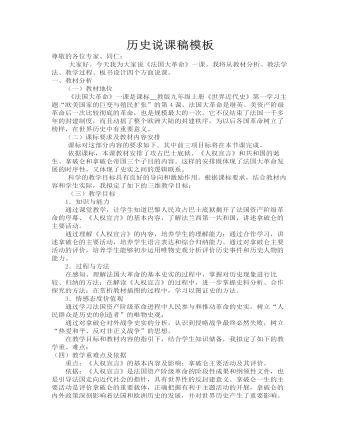
《法国大革命》说课稿
课标对这部分内容的要求如下。其中前三项目标将在本节课完成。依据课标,本课教材安排了攻占巴士底狱、《人权宣言》和共和国的诞生、拿破仑和拿破仑帝国三个子目的内容。这样的安排既体现了法国大革命发展的时序性,又体现了史实之间的逻辑联系。科学的教学目标具有良好的导向和激励作用。根据课标要求,结合教材内容和学生实际,我拟定了如下的三维教学目标:(三)教学目标1.知识与能力通过课堂教学,让学生知道巴黎人民攻占巴士底狱揭开了法国资产阶级革命的序幕、《人权宣言》的基本内容,了解法兰西第一共和国,讲述拿破仑的主要活动。